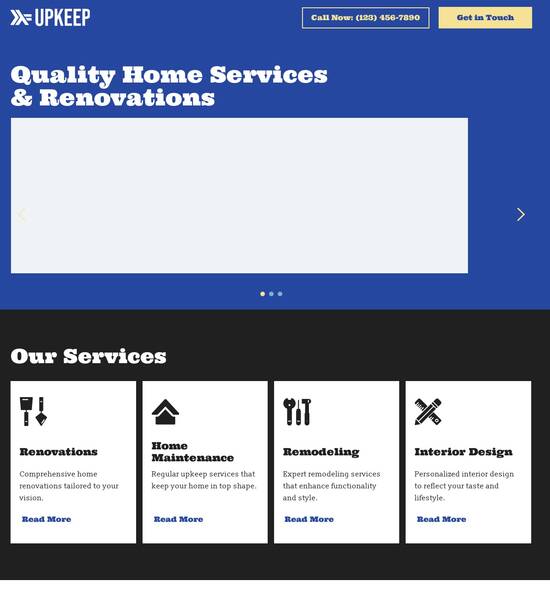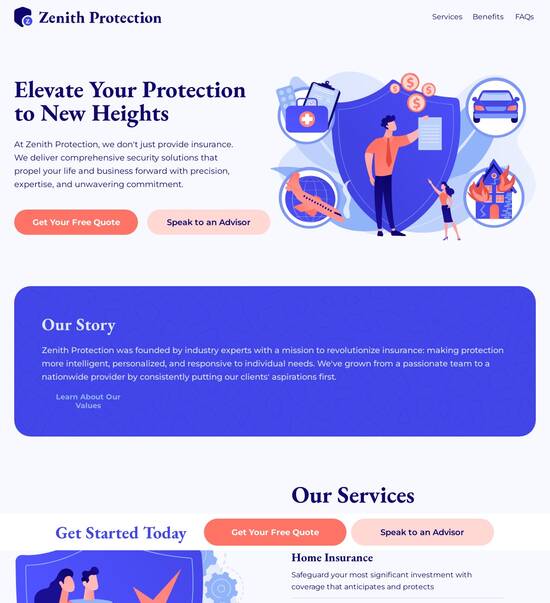
Home page template for Podiatrists
Explore Similar TemplatesAbout template
Master your online marketing with this builder for home page template for Podiatrists. Try more tools to create an immaculate landing page.
Recommended templates

Easy to build without coding
With the intuitive drag-and-drop builder, anyone on your team can create high-converting pages without any knowledge of code or design. Make enhancements to your landing page with custom widgets using Javascript, HTML/CSS, or third-party scripts.

Multiple layouts for any industry and goal
Select from 500+ landing page layouts built to boost conversions across industry-specific scenarios. Customize them by adjusting fonts, adding images, and generating on-brand content with the AI assistant. Quickly scale with Instablocks® and Global Blocks that you can save, reuse, and update globally.

Loads fast and looks polished on any device
Every template is responsive, which means they present professionally on any device and load blazingly fast with our Thor Render Engine. You can also power them up with Google AMP technology to deliver an unparalleled mobile experience and drive higher conversions.

Robust analytics & experimentation
Get real-time updates and reporting across all your devices, showing the number of visitors, conversions, cost-per-visitor, and cost-per-lead. Launch AI-powered experiments, run A/B tests, and use heatmaps to analyze user behavior, then optimize your landing page to maximize conversions.







Easy to build without coding
With the intuitive drag-and-drop builder, anyone on your team can create high-converting pages without any knowledge of code or design. Make enhancements to your landing page with custom widgets using Javascript, HTML/CSS, or third-party scripts.
Multiple layouts for any industry and goal
Select from 500+ landing page layouts built to boost conversions across industry-specific scenarios. Customize them by adjusting fonts, adding images, and generating on-brand content with the AI assistant. Quickly scale with Instablocks® and Global Blocks that you can save, reuse, and update globally.
Loads fast and looks polished on any device
Every template is responsive, which means they present professionally on any device and load blazingly fast with our Thor Render Engine.
Robust analytics & experimentation
Get real-time updates and reporting across all your devices, showing the number of visitors, conversions, cost-per-visitor, and cost-per-lead. Launch AI-powered experiments, run A/B tests, and use heatmaps to analyze user behavior, then optimize your landing page to maximize conversions.
All the features you need to build podiatry website design
Explore more featuresLearn how to build podiatry website design template
Frequently asked questions about podiatrist website design
Leading the way in building high-performing landing pages





Chiropodist web design: Your ultimate how-to guide
Creating effective landing pages is crucial for capturing leads and optimizing digital marketing campaigns. With Instapage, marketers can leverage their all-in-one platform to access over 100 high-converting templates geared towards various industries, including business services, tech/SaaS, education, and more. These templates provide a solid foundation for crafting pages that not only engage visitors but also encourage conversions.
Choosing the Right Template
When selecting a landing page template, consider the specific needs of your audience. For example, business services might benefit from a clean and straightforward design that emphasizes professionalism. In contrast, a tech/SaaS company may want an innovative layout that showcases their unique features. Here’s what to look for:
- Ease of customization: Ensure the template can be easily modified to fit your brand's style.
- Mobile responsiveness: A significant portion of web traffic comes from mobile devices, so choose a template that looks great on all screen sizes.
- Lead generation elements: Templates should include forms, buttons, and calls to action that facilitate user engagement.
Personalizing Your Landing Page
Once you've chosen your template, personalization is key to maximizing conversions. Instapage offers dynamic text replacement features that help tailor content to specific segments of your audience. This means relevant keywords and phrases can be automatically updated based on the visitors' search terms. Implement these strategies:
- Use audience segmentation: Divide your audience based on demographics or behaviors to create tailored experiences.
- Implement retargeting: Utilize data tools to show ads to visitors who previously interacted with your site, reminding them of your offerings.
- A/B testing: Experiment with different headlines, images, and content variations to see what resonates best with your target audience.
Optimizing for Conversions
After launching your landing page, the optimization process begins. Instapage provides built-in experimentation features to help refine your pages. This involves:
- Utilizing heatmaps: Analyze on-page behavior to see where visitors click and scroll, allowing for informed adjustments to your design.
- Conducting A/B tests: Regularly test different versions of your landing page to evaluate which performs better in terms of user engagement and conversions.
- Reviewing analytics: Use the Instapage dashboard to track the performance of your pages and make data-driven decisions.
By implementing these strategies, you’ll not only boost the effectiveness of your landing pages but also enhance your overall marketing efforts.
Start utilizing Instapage today to transform your landing page creation and optimize your marketing campaigns effortlessly.
Ready to get started? Sign up for Instapage and unlock the full potential of your marketing strategy with high-converting landing pages tailored to your audience.
People also ask about chiropodist website design
Home page template for podiatrists: Creating a welcoming digital space
Understanding the unique needs of podiatrists in web design
Podiatrists face specific challenges that require tailored web design strategies. Understanding the unique demographics of their patient base, which may include athletes, elderly individuals, and those with diabetes or other foot-related issues, is critical. Each group has distinct needs and concerns regarding foot health, injury prevention, and treatment options. A podiatrist’s homepage should reflect an understanding of these varying needs, fostering an immediate connection with visitors.
Visual appeal plays a significant role in establishing professional credibility. A clean, modern layout with appropriate colors and images can help to reassure potential patients about the quality of care they will receive. Healthcare regulations also dictate that web pages must maintain a level of professionalism, ensuring that the design is not only aesthetically pleasing but also compliant with ethical guidelines.
Legal aspects in healthcare web design include adhering to HIPAA regulations, ensuring patient privacy and security when collecting information through forms. Any home page template for podiatrists must incorporate security features, affirming the commitment to safeguarding patient data.
Defining the role of a home page for podiatrists
The home page serves as the digital front door to a podiatry practice. An inviting, well-designed homepage creates a welcoming digital environment for visitors. It is crucial to make an excellent first impression, as many patients will determine the quality of care from their initial engagement with the website.
Patients typically seek specific information such as available services, contact details, and the credentials of the practice. Consequently, these elements must be immediately identifiable on the homepage. A well-structured navigation pathway will enhance user experience, allowing patients to locate information swiftly and efficiently.
Innovating web design for podiatric practices
A successful home page template for podiatrists includes essential features that cater to the specific needs of the practice. Engaging hero sections grab visitors' attention as soon as they arrive, showcasing the practice’s core values or specialties. This can be achieved through stunning imagery or compelling calls to action that resonate with prospective patients.
Navigation menus should be tailored to podiatry practices, with clearly labeled options linked to services, patient resources, and contact information. Additionally, mobile responsiveness has become non-negotiable, as a growing number of patients will access the website via smartphones or tablets. Ensuring that the site adapts to various screen sizes enhances user satisfaction.
Showcasing trust and reliability
Building trust is paramount in healthcare, and podiatrists must utilize strategic elements on their homepage to convey reliability. Integrating patient reviews and testimonials not only adds social proof but personalizes the experience for new patients. Highlighting successful outcomes with real stories can significantly influence potential patients’ decisions.
Professional certifications and affiliations with recognized health organizations should be prominently displayed to reinforce credibility. In addition, trust badges, indicating secure forms and data collection methods, can alleviate patient concerns regarding privacy and security, promoting a trustworthy environment.
Intuitive patient interaction elements
To enhance patient interaction on the website, implementing convenient features such as appointment scheduling tools can simplify the booking process. Patients should feel empowered to book an appointment without hassle, ideally through a user-friendly calendar interface that syncs with office schedules.
Adding patient education tools is also vital in a podiatry practice. This can include infographics that illustrate common foot conditions and preventative care tips. Such resources not only engage visitors but also encourage proactive health management. Additionally, equipping the site with contact forms and chat systems allows for streamlined communication, offering patients answers to their inquiries promptly.
Optimal content strategies for podiatry home pages
Crafting compelling content is key to engaging visitors. The language used should be patient-centric, respecting the terminology and emotions of the audience. Simplifying complex medical jargon into relatable language fosters understanding and comfort, establishing rapport from the first interaction.
Highlighting specialized services can elevate the practice’s visibility. This includes using coding and analytics to optimize content delivery, ensuring that information about specific treatments or services can be easily found by those actively searching for podiatric care.
Visual design and branding for podiatry practices
Color schemes are integral to branding in healthcare. A well-chosen palette can evoke emotions and influence behavior. Calming shades of blue or green may help patients feel more at ease while promoting a sense of trust. Imagery should also be chosen carefully, avoiding overly clinical pictures that can deter visitors.
Typography plays an equally important role; it must be highly legible, allowing visitors to absorb information effortlessly. Integrating infographics to explain procedures visually can simplify complex concepts, making the information more digestible for all patients.
Enhancing functionality with multimedia
Leveraging multimedia features can significantly boost engagement and educational value on a podiatrist's homepage. Video content, such as virtual tours or introductory messages, can personalize the experience, giving patients a feel for the environment and the team before they arrive.
Success stories in video or written format, showcasing the benefits and outcomes of treatments, not only serve as testimonials but also as motivation for potential patients to seek care. Furthermore, incorporating infographics to explain various procedures in a straightforward manner can help demystify treatment plans for anxious or uninitiated patients.
The role of systems integration in podiatry websites
Web design for podiatrists should incorporate systems integration to streamline various administrative functions. Connecting the website with electronic health record (EHR) systems facilitates smoother operations, improving appointment logistics and patient tracking.
Insurance verification features are another essential addition, allowing patients to understand their coverage before scheduling. By providing these services online, practices can improve efficiency and enhance the patient experience. Additionally, incorporating web forms for patient data can simplify registration and minimize paperwork at the clinic.
Driving patient interaction and retention
Optimizing the homepage for SEO is crucial for attracting new patients. Implementing local SEO strategies can elevate the practice's visibility to nearby residents searching for podiatry services. Focusing on keyword optimization that relates explicitly to podiatric care and services ensures that the website ranks higher in search engine results.
In addition to attracting new visitors, it is vital to retain existing patients through engaging, relevant content. Building a template that allows for regular updates and content enrichment can enhance relationships. Utilizing A/B testing to understand which elements of the homepage perform best ensures continuous improvement.
Future trends in podiatry web design
The landscape of patient interaction is evolving, driven by emerging technologies. Telemedicine has risen in popularity, and podiatrists must consider how to effectively integrate virtual appointments into their web design. This not only broadens the scope of patient interaction but also aligns the practice with contemporary healthcare delivery methods.
Moreover, technologies like virtual reality (VR) and augmented reality (AR) can play a role in patient education, allowing patients to visualize procedures or treatment options. As patient privacy and data security become even more critical, practices will need to adopt advanced measures to ensure compliance with regulations while providing a safe online experience.
Adapting to change: continuous improvement in practice
It is essential for podiatry practices to remain adaptable and aware of the best practices in healthcare web design. Regular updates in response to patient feedback can help enhance the website's functionality and attractiveness. Building feedback loops with patients allows practices to understand their needs better and adjust offerings accordingly.
Emphasizing adaptive design is crucial to meet the changing expectations of patients. As technology evolves and new trends emerge, podiatrists should be prepared to make iterative changes that continue to align the website with patient-centered care and engagement.
Impactful closing thoughts
Rethinking a podiatry practice’s online presence through innovative web solutions can lead to transformative impacts. A well-designed homepage plays a crucial role in creating a welcoming environment, fostering trust, and ultimately increasing patient bookings and retention.
Practicing web optimization is an ongoing journey; taking actionable steps to enhance the digital experience is vital. Aligning technology with patient care stands as a hallmark of a successful podiatric practice, so embracing these web strategies is essential for progress.
Ready to skyrocket conversions?
Supercharge your ad campaigns with high-performing landing pages
Get started














